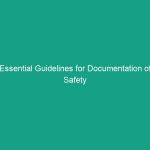Introduction
In today’s fast-paced work environments, ensuring food Safety in the workplace has become a top priority for organizations across various sectors, especially in the food service and hospitality industries. The Health, Safety, and Environment (HSE) framework emphasizes the necessity of maintaining high Safety Standards to protect employees, consumers, and the overall integrity of the business. The importance of Workplace Safety cannot be overstated; it not only helps to prevent illnesses and accidents but also enhances productivity and fosters a positive work culture.
Understanding the critical risks associated with food safety is essential for any organization that handles food. From contamination to inadequate Training, the potential Hazards are numerous and can have severe consequences. This article will delve into the essential aspects of food safety in the workplace, covering regulatory frameworks, best practices, case studies, challenges, and future trends to provide a Comprehensive Guide for businesses aiming to enhance their food safety protocols.
Regulatory Frameworks for Food Safety
Regulatory frameworks provide the backbone for food safety practices, outlining the legal obligations that organizations must adhere to in order to ensure safe food handling. In the United States, the Food and Drug Administration (FDA) and the United States Department of Agriculture (USDA) set forth guidelines that govern food safety standards.
Key Regulations and Standards
The FDA’s Food Safety Modernization Act (FSMA) is pivotal in shifting the focus from responding to foodborne illness outbreaks to preventing them. This law mandates comprehensive controls for food safety, requiring businesses to implement hazard analysis and risk-based preventive controls.
Some other important regulations include:
- HACCP (Hazard Analysis Critical Control Point): A systematic preventive approach to food safety that identifies physical, chemical, and biological Hazards in production processes.
- ServSafe: A food safety training and certification program that educates food service employees on safe food handling practices.
- State and Local Regulations: Many states have their own food safety regulations that may require additional compliance measures beyond federal laws.
Importance of Compliance
Compliance with these regulations is not merely a legal obligation but a critical component of a successful food safety program. Organizations that neglect to adhere to food safety regulations risk significant penalties, including fines and lawsuits, not to mention the potential damage to their reputation. Furthermore, staying compliant helps ensure that customers receive safe food, thus preventing foodborne illnesses and maintaining public trust.
Best Practices for Food Safety in the Workplace
Implementing Best Practices for food safety in the workplace is essential for minimizing risks and ensuring the well-being of employees and customers alike. Here are some of the most effective strategies that organizations can adopt:
Training and Education
Regular training for employees is one of the most effective ways to promote food safety in the workplace. This training should cover essential topics such as proper food handling techniques, personal hygiene, and the importance of temperature control. Employees must understand the critical role they play in maintaining food safety and the potential consequences of neglecting safety standards.
Interactive Training Methods
Instead of traditional lectures, consider using interactive training methods, such as role-playing scenarios and hands-on workshops. This approach not only engages employees but also reinforces their learning by allowing them to apply concepts in real-world situations.
Sanitation Practices
Maintaining a clean and sanitary workplace is crucial for food safety. Regular cleaning schedules should be established to ensure that all surfaces, utensils, and equipment are thoroughly cleaned and sanitized. Employees should also be encouraged to practice good personal hygiene, such as frequent handwashing and wearing appropriate clothing when handling food.
Cross-Contamination Prevention
Cross-contamination is a leading cause of foodborne illnesses, making it essential to implement measures to prevent it. This can be achieved by:
- Using separate cutting boards for raw meat and vegetables.
- Storing raw foods below ready-to-eat foods in the refrigerator.
- Regularly sanitizing surfaces that come into contact with food.
Proper Food Storage
Food storage practices significantly impact food safety. It’s crucial for organizations to adhere to the following guidelines:
- Store food at the correct temperatures to prevent spoilage.
- Ensure all food items are labeled and dated to track freshness.
- Avoid overstocking to maintain airflow and reduce the risk of spoilage.
Case Studies: Lessons Learned from Food Safety Incidents
Learning from real-world case studies can provide valuable insights into the importance of adhering to food safety protocols. Several high-profile food safety incidents have highlighted critical failures and the consequences of neglecting food safety in the workplace.
Case Study 1: The Chipotle Outbreak
In 2015, Chipotle Mexican Grill faced a series of foodborne illness outbreaks linked to E. coli and Norovirus. The incidents resulted in hundreds of illnesses and led to a significant decline in customer trust. Investigations revealed lapses in food safety practices, including improper food handling and inadequate employee training. In response, Chipotle revamped its food safety program, investing in employee training and implementing stricter food handling protocols.
Case Study 2: The Peanut Corporation of America
Another notable case is that of the Peanut Corporation of America, which was linked to a salmonella outbreak that resulted in nine deaths and hundreds of illnesses. The company’s failure to adhere to food safety regulations and perform adequate testing led to severe legal repercussions and the eventual bankruptcy of the business. This case emphasizes the importance of maintaining rigorous food safety standards and the potential consequences of neglect.
Challenges in Implementing Food Safety Practices
While the importance of food safety in the workplace is clear, organizations often face several challenges in implementing effective practices. Understanding these challenges is crucial for developing strategies to overcome them.
Employee Compliance
One of the significant challenges is ensuring that all employees comply with food safety protocols. Employees may become complacent or forgetful over time, leading to lapses in food safety practices. Regular training sessions, reminders, and a strong company culture that prioritizes safety can help address this issue.
Resource Limitations
Many organizations, especially small businesses, may struggle with limited resources to implement comprehensive food safety programs. This includes financial constraints for training, purchasing equipment, and maintaining adequate staffing levels. Organizations should seek ways to prioritize food safety within their budgets, potentially utilizing free or low-cost training resources available online.
Keeping Up with Regulations
The ever-evolving nature of food safety regulations can also pose a challenge. Organizations must stay informed about changes to laws and standards to ensure compliance. This may require dedicating staff time to research and training, but the investment is crucial to maintain food safety and protect the business.
Future Trends in Food Safety
As technology advances, the landscape of food safety is changing. Organizations must remain adaptable to new trends and innovations that can enhance food safety practices.
Technological Innovations
Emerging technologies, such as blockchain and IoT (Internet of Things), are set to revolutionize food safety in the workplace. Blockchain can provide traceability for food products, allowing organizations to track the source of ingredients and ensure compliance with safety standards. IoT devices can monitor food temperatures and alert staff to potential issues in real-time, reducing the risk of spoilage and contamination.
Focus on Sustainability
There is an increasing emphasis on sustainability within the food industry, which also impacts food safety. Sustainable practices, such as sourcing local ingredients and reducing food waste, can contribute to safer food handling practices. Organizations that prioritize sustainability are likely to see enhanced customer loyalty and trust.
Enhanced Training Methods
As training becomes more crucial in maintaining food safety, organizations are likely to adopt more advanced training methods, such as virtual reality (VR) and augmented reality (AR). These technologies can create immersive training experiences that engage employees and reinforce their understanding of food safety protocols.
Conclusion
Ensuring food safety in the workplace is an ongoing commitment that requires diligence, training, and adherence to regulatory standards. As highlighted throughout this article, the potential risks associated with food safety are significant, but with the right practices in place, organizations can mitigate these risks and protect their employees and customers. By prioritizing food safety, businesses can foster a culture of safety that not only enhances their reputation but also contributes to overall operational success.
As you reflect on the importance of food safety in your workplace, consider conducting a thorough review of your current practices. Are there areas for improvement? What new training methods can you implement? Take action today to strengthen your food safety protocols and ensure a safe working environment for all.


